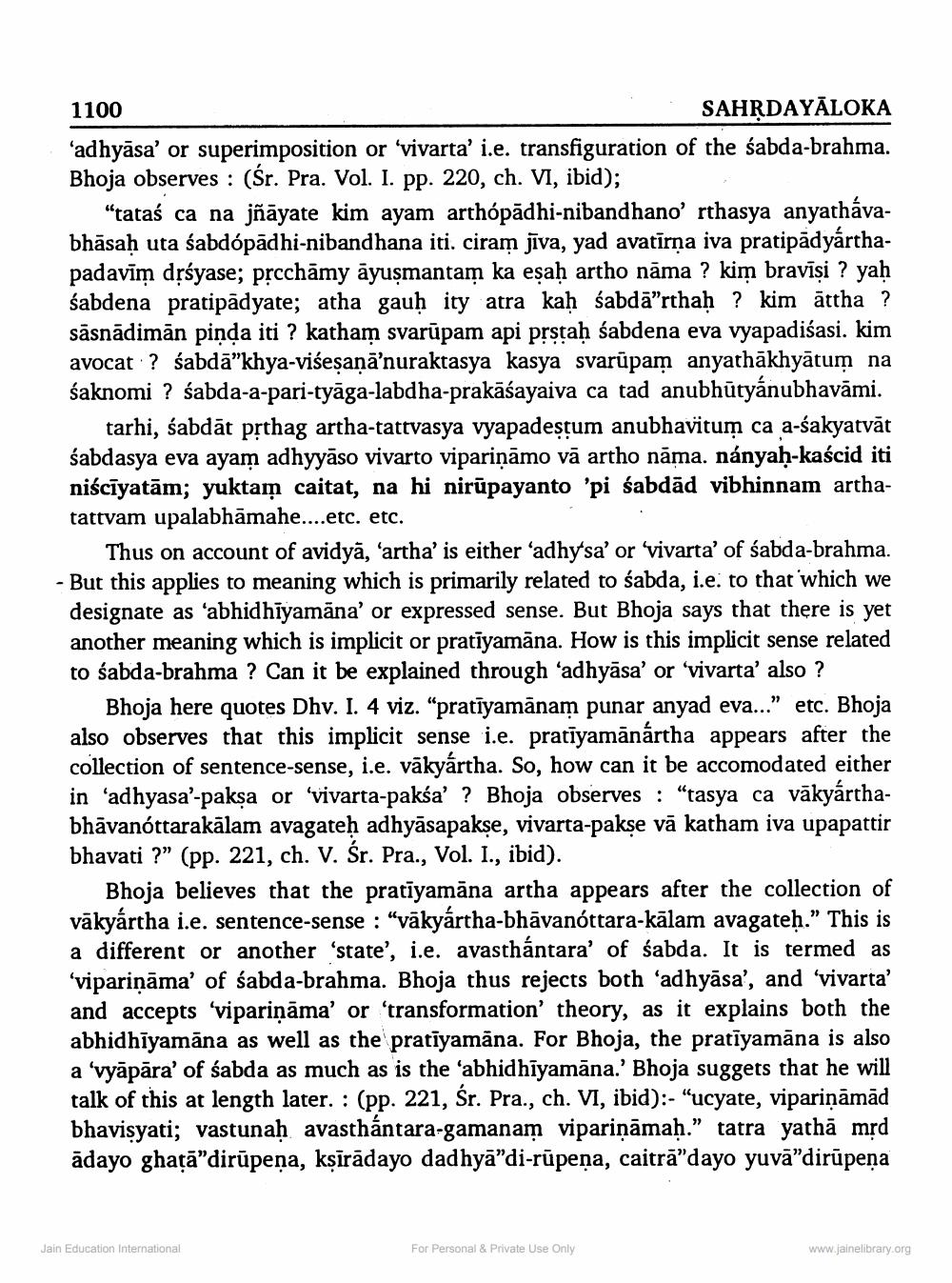________________
1100
SAHRDAYĀLOKA 'adhyāsa' or superimposition or 'vivarta' i.e. transfiguration of the sabda-brahma. Bhoja observes : (śr. Pra. Vol. I. pp. 220, ch. VI, ibid);
"tataś ca na jñāyate kim ayam arthópādhi-nibandhano' rthasya anyathávabhāsaḥ uta śabdópādhi-nibandhana iti. ciram jīva, yad avatīrņa iva pratipadyárthapadavīm drśyase; prcchămy āyuşmantam ka eṣaḥ artho nāma ? kim bravīși ? yaḥ śabdena pratipădyate; atha gauḥ ity atra kaḥ śabdā”rthaḥ ? kim ättha ? sāsnādimān pinda iti ? katham svarūpam api prstaḥ śabdena eva vyapadiśasi. kim avocat? śabdā”khya-viśesaņā’nuraktasya kasya svarūpam anyathākhyātum na saknomi ? śabda-a-pari-tyāga-labdha-prakāśayaiva ca tad anubhūtyánubhavāmi.
tarhi, śabdāt prthag artha-tattvasya vyapadestum anubhavitum ca a-sakyatvāt śabdasya eva ayam adhyyāso vivarto vipariņāmo vā artho nāma. nányah-kaścid iti niścīyatām; yuktam caitat, na hi nirūpayanto 'pi śabdād vibhinnam arthatattvam upalabhāmahe....etc. etc.
Thus on account of avidyā, 'artha' is either 'adhy'sa' or 'vivarta' of sabda-brahma. - But this applies to meaning which is primarily related to śabda, i.e. to that which we designate as ‘abhidhīyamāna' or expressed sense. But Bhoja says that there is yet another meaning which is implicit or pratīyamāna. How is this implicit sense related to śabda-brahma ? Can it be explained through ‘adhyāsa' or 'vivarta' also ?
Bhoja here quotes Dhv. I. 4 viz. “pratīyamānam punar anyad eva..." etc. Bhoja also observes that this implicit sense i.e. pratīyamānártha appears after the collection of sentence-sense, i.e. vākyártha. So, how can it be accomodated either in 'adhyasa'-pakṣa or 'vivarta-paksa'? Bhoja observes : “tasya ca vākyárthabhāvanóttarakālam avagateh adhyāsapakse, vivarta-pakse vā katham iva upapattir bhavati ?” (pp. 221, ch. V. Śr. Pra., Vol. 1., ibid).
Bhoja believes that the pratiyamāna artha appears after the collection of vākyártha i.e. sentence-sense : "vākyartha-bhāvanóttara-kālam avag a different or another 'state', i.e. avasthántara' of śabda. It is termed as 'vipariņāma' of śabda-brahma. Bhoja thus rejects both 'adhyāsa', and 'vivarta’ and accepts 'vipariņāma' or 'transformation theory, as it explains both the abhidhīyamāna as well as the pratīyamāna. For Bhoja, the pratīyamāna is also a 'vyāpāra' of śabda as much as is the ‘abhidhiyamāna.' Bhoja suggets that he will talk of this at length later. : (pp. 221, Śr. Pra., ch. VI, ibid):- “ucyate, vipariņāmād bhavisyati; vastunaḥ avasthántara-gamanam vipariņāmaḥ.” tatra yathā mặd ādayo ghatā”dirūpeņa, kşīrādayo dadhyā”di-rūpena, caitrā”dayo yuvā”dirūpeņa
Jain Education International
For Personal & Private Use Only
www.jainelibrary.org




